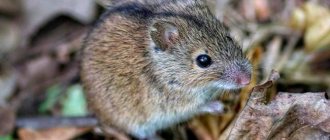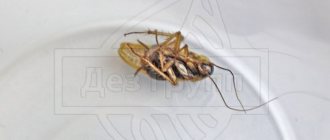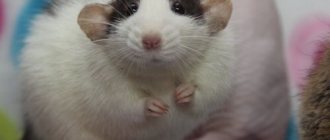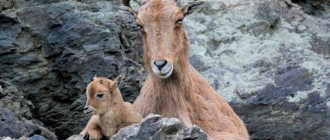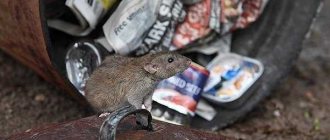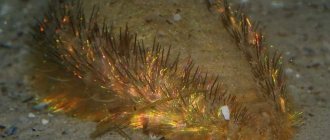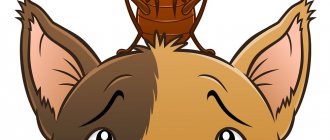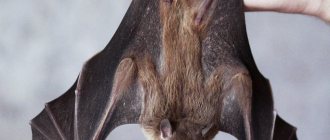Domestic decorative rats - the best breeds
The ancestor of the domestic rat is considered to be the gray rat - pasyuk. In the process of adapting to home conditions, the rodent's physique, color, temperament and attitude towards humans changed. The lifespan of a rodent is 3-6 years, depending on the conditions of detention and care.
Decorative rats of the standard breed
The standard is the most common breed among domestic rats. The rodent is quite large, with an elongated body and short shiny fur.
- A distinctive feature of the breed is considered to be a body size of 24-26 cm and a tail of 20-25 cm;
- The eyes are round and harmonize with the coat color. The ears are wide and round in shape;
- rat weight: from 200 to 500 g, depending on gender and feeding and maintenance conditions.
Rats of this breed become attached to their owner and, even when treated rudely, do not behave aggressively, do not attack or bite.
Rex
In terms of body type, rexes are similar to the standard breed, however, they have dense curly hair, which is not particularly glossy and soft.
- the mustache is short and curled at the tips, the skin is dull;
- size 7-20 cm, weight 200-500 g;
- the color is standard colors, the spots sometimes merge due to the unevenness of the hairline.
Pets love to play with their owners, and not just be nearby. They prefer to be the center of attention, so they are easy to train. They adapt to the owner’s daily routine and do not interfere at night.
Double Rex breed
Double Rex is an improved version of the previous breed. The only difference is the double hairline characteristic of rodents. The coat is short, and the fur is constantly twisted in a spiral; even fur is present on the abdomen.
Rats shed more often than others and require additional care for their fur.
Tailless rats
From the name it becomes clear that the rat does not even have the rudiment of a tail. The body of the rodent is pear-shaped, the head is larger than that of the Standard. The bigger the ears, the better.
- have different colors in any color scheme, complete absence of hair is allowed;
- size 20-25 cm, weight 200-500 g.
Rats are very smart and playful, but they need time to get used to a new home, so for the first couple of days they will be wary of the home. Sometimes there is a problem with breeding offspring, and the babies born are not always tailless.
Satin decorative rats
Satin or satin rats have a standard build and come in a variety of colors.
- the main advantage of the breed is its wool: thin and long, soft to the touch, with a characteristic shine;
- size 8-25 cm, weight 350-800 g.
Would you like a rat with smooth satin fur? Poll Options are limited because JavaScript is disabled in your browser.
Pets are cunning, but they are not vindictive. Unlike other breeds, satin rats are unpretentious and like to hide in furniture, so keep a close eye on the rodent when it walks around the apartment.
Breed of hairless rats
Rats are completely hairless. Small fuzz is found in the area above the eyes, on the wrists and ankles. The skin is bright, without spots or blemishes. Folds are allowed. The skin of males is thicker than that of females and is pleasant to the touch.
- adult size 15-30 cm, weight from 300 to 700 g;
- life span: 1.5 - 2 years, but favorable conditions will prolong the baby’s life.
Animals are clean, so they do not cause inconvenience when walking around the apartment. Suitable for people prone to allergies.
Dumbo breed
The Dumbo breed, like tailless rats, was bred artificially, so the rodents have a pear-shaped physique. Unlike other rats, Dumbo's head is wider and its muzzle looks more pointed.
- the main difference from its relatives is its large, low-set ears;
- size 15-20 cm, weight 250-500 g;
- There are two ear shapes: open and “tulip”, when the edge is slightly lowered down.
Like other breeds, Dumbo quickly gets used to its owner and loves to lie on laps and sit on shoulders. They quickly get used to the tray and keep it clean.
Downy breed of decorative rats or Fuzz rats
The Fuzz rat got its name from its thin, matted gray fur that shows through the body of the rodent. The antennae are short and not evenly spaced; the fluff on the head creates the feeling as if the pet is bald.
Wavy or corduroy varieties of ornamental rats
Wavy rats completely repeat the characteristics of the Standard breed, differing only in the protruding hairs.
- The fur of corduroy rats is wavy, thick, dense, slightly tousled;
- undercoat is present. The mustache is long with small waves at the ends;
- size 15-20 cm, weight 300-500 g.
External characteristics
House mice Rodents have been seen by almost all people living on the planet. True, everyone’s reaction to this meeting was different. No wonder. Many are even afraid of these nimble creatures, although they can only cause trouble for people in material terms: destroy the harvest, chew wiring and building materials, damage cars and furniture.
The house mouse is a mammal with a long tail and an oval body. The size of the animal ranges from 6.5-9.5 cm. Some are interested in the question of how much a house mouse weighs if the tail, covered with sparse short hair and horny scales, makes up almost 60% of the body length. The answer is ambiguous and on average the weight of a rodent is about 12-30 grams.
The house mouse in the photo shows its color well. But the color of the coat varies depending on the habitat and ranges from a light sandy tone to a dark brown shade. The abdomen of all subspecies is white or light gray. Mice, which are bred as ornamental pets, can be white, blue-gray, black, yellow and motley. Female house mice have 5 pairs of nipples. Sexual differences within the species are weakly expressed.
How to extend the life of a pet
If a person has a question about how many years mice live, then he is probably also interested in how to extend the life of a pet in this world. If such a goal is set, then it must be followed, and for this it is necessary:
- create the most comfortable living conditions,
- balance the diet and bring it as close as possible to the needs of a small organism,
- protect the animal from domestic predators,
- monitor the baby’s health, which also depends on microclimate parameters, compliance with hygiene rules and the intake of nutrients.
Effect of feeding on lifespan
If we are talking about proper nutrition, then the best option would be to use ready-made food intended for rodents. As a rule, they are already fully balanced in proteins, fats, carbohydrates and vitamins. In this case, you won’t have to rack your brains about what to give, how to give and in what quantity - all the necessary information is already indicated on the package.
Making the mixture yourself is much more difficult, but you will be sure that all the ingredients are of excellent quality. When mixing, take into account the nutritional needs of the mouse body. According to it, the diet should consist of 14% protein, 10% fat and 9% fiber.
Daily ration in g
| Stern | Adults | Individuals weighing less than 14 g | Individuals weighing less than 22 g |
| Greens or hay | 6,0 | 2,5 | 3,0 |
| Grain mixture | 12,0 | 5,0 | 7,0 |
| Juicy feed | 3,0 | 1,5 | 2,0 |
| Groats | 3,0 | 1,0 | 2,0 |
| Milk | 10,0 | 4,0 | 4,0 |
| Bone meal | 0,2 | 0,1 | 0,2 |
| Fish meal | 0,3 | 0,1 | 0,2 |
| Fish fat | 0,1 | 0,5 | 0,5 |
| Table salt | 0,1 | 0,05 | 0,1 |
| White bread | 1,8 | 0,9 | 1,3 |
| Feed yeast | 0,2 | 0,1 | 0,1 |
You can feed grains, plant seeds, vegetables, grass and green parts of plants.
You should not overuse foods such as nuts and seeds, they are rich in protein, interfere with the normal functioning of the liver, and excess protein food often leads to obesity, which negatively affects the life expectancy of a tiny animal.
Dependence of life on living conditions
There is no point in discussing this topic for a long time, so everyone understands perfectly well the importance of creating comfort for children. The basic rules are as follows:
the cage should be as spacious as possible, the house should not be installed in a draft or in direct sunlight, the rodent’s home should be placed in an inaccessible place for both children and domestic predators, such as a cat or dog.
- the cage should be as spacious as possible,
- the house should not be installed in a draft or in direct sunlight,
- The rodent's home is placed in an inaccessible place for both children and domestic predators, such as a cat or dog.
It is equally important to provide a microclimate. It is known that prolonged exposure to low or very high temperatures negatively affects the vital processes of the baby, which means that the chance of losing a pet ahead of schedule increases sharply
A similar effect is observed in high humidity conditions.
The optimal parameters are as follows: temperature - 18-20 ° C, humidity, no more than 70%.
It is worth taking care of walks outside of your regular pastime. If this is practiced, then the animal should walk in the safest conditions possible:
- without children who could step on it,
- in the absence of other pets,
- eliminates the possibility of “collision” with electrical wires or sockets,
- Animals are not allowed to enter secluded places from where it would be problematic to smoke them out.
Impact of reproduction
It is worth understanding that incorrectly carried out work on breeding mice also has a huge impact on the life expectancy of both the parents themselves and future offspring. In order not to indirectly reduce the lifespan of decorative babies, they adhere to simple rules:
- do not crossbreed animals before puberty,
- weak, sick, obese and elderly pets are not allowed to breed,
- do not allow frequent births, the female should become pregnant no more than twice a year,
- males are also given a break; frequent participation in reproduction depletes vitality, reduces the quality of sperm, and therefore affects both the health and development of future pups,
- there should not be more than 10 females per breeder,
- monitor the quality of feeding of the expectant mother.
Only compliance with these not very complicated rules will save the life and health of your pets, which means they will not die before the allotted time.
| Kinds | Pregnancy, days | Lactation period, days | Number of litters | Number of cubs per year |
| White mouse | 17-22 | 20 | 8 | 2-13 |
| Yellow-necked mouse | 20-22 | 20-25 | 5 | 25 |
| Little mouse | 18-20 | , | 3-4 | , |
| Harvest mouse | 20-21 | 20-25 | 4 | 40 |
Influence of nutrition
It is recommended to give your pet a ready-made, balanced food. Since per day the mouse must eat:
- greens – 6 g;
- grain – 12 g;
- succulent food – 3 g;
- cereals – 3 g;
- flour, including bone flour – 0.3 g;
- fish oil – 0.1 g;
- milk – 10 g;
- salt – 0.1 g;
- bread – 1.8 g;
- feed yeast – 0.2 g.
Nuts and seeds are given periodically. Abuse of these products leads to obesity.
It is much more dangerous for an animal to be without water. In the absence of liquid in the wild, the mouse eats the succulent parts of the plant. A pet locked in a cage, deprived of water, finds itself in much worse conditions. How long an animal can survive without fluid is also interesting. A mouse lives without food and water for no more than 3 days.
How many mice does a mouse give birth to?
Like all small rodents, mice have increased fertility. If mice are kept in good conditions and given good nutrition, they can breed throughout the year. A mouse can bear an average of 5-10 litters per year. In one litter, as a rule, there are from 1 to 15 mice.
Mice are born without hair, their eyes and ears are closed. They are helpless and hardly move. On days 3-5 after birth, the baby mice's ears open and fur begins to grow. Mice's eyes open at the age of two weeks. And at three weeks of age, the pups get out of the nest and begin to consume food on their own. Young animals can be separated from the female 3-3.5 weeks after birth.
average life expectancy
In such dangerous living conditions, surrounded by numerous enemies, the main one of which is man, a mouse cannot live long.
House mouse pest
The small animal has a size of 6 to 9 cm, the tail is half the length of the body. Weight from 12 to 30 g. This rodent moved along the earth together with humans and gradually inhabited all continents.
Near a person it eats anything. Eats candles, soap and other products that it finds in the house and barns.
It is extremely fertile. It produces up to 5-10 offspring per year. The record is 14. From 3 to 12 babies are born, which become capable of reproducing after 5-7 weeks.
This ability to reproduce makes mice unpleasant and dangerous neighbors. An overgrown population can cause great damage to agricultural supplies.
The lifespan of a house mouse is less than 2 years. In captivity, life expectancy increases due to comfortable living conditions. Regular feeding, accessible water and constant temperature extend the life span to 2-3 years.
Interesting: The life expectancy record for a laboratory rodent is almost 5 years.
Mouse in nature
Life expectancy in the wild is even shorter; too many dangerous factors shorten this life span. There are a large number of predators for which the mouse is the object of hunting. Changing weather and climate conditions, ecology make life shorter.
Under natural conditions, a rodent lives 12 months, rarely living to 18.
How to fight spiders using traditional methods
Folk remedies and methods will help in the fight against spiders if the case is not advanced. The simplest method, as noted above, is to get rid of the food source of arthropods: cockroaches, midges, mosquitoes and other insects. You shouldn’t feel sorry for the cobwebs woven by predators in the corners of the house. It is better to clean it with a damp cloth, taking the spiders along with it.
In a private house, with an abundance of vegetation under the windows and in the yard, it makes sense to use boric acid in the fight against spiders. A special effect can be achieved by combining acid with a vacuum cleaner, which can easily remove all spiders, including those from hard-to-reach places.
It is believed that spiders do not like the aroma of citrus fruits, chestnuts and hazelnuts. If you place particles of products with odors they hate around the house, especially in places where they accumulate, you can achieve a deterrent effect.
Not the easiest, but effective method is home renovation. Spiders cannot stand the smell of paint, whitewash, or putty. Replacing the floor and wallpaper followed by general cleaning will get rid of arthropods for a long time and help refresh the interior.
Another folk remedy against domestic arthropods is mint. Even a small amount of a fragrant plant placed in the corners of the house will scare away spiders. You can enhance the effect with the help of peppermint aromatic oil, sprayed through a spray bottle around the house in spider habitats. The same effect can be achieved using eucalyptus or tea tree oil.
House conditions
In order to ensure a comfortable existence for your mouse, it is important for the owner to know how to keep mice.
Mouse cage
A metal cage is suitable as a permanent place of residence for a mouse, since the mouse can easily chew through plastic. The size of the cells is no more than a square centimeter, otherwise the animal will crawl through and run away.
Minimum dimensions of housing for a mouse: 30x30x40 centimeters.
The cage itself must be placed in a baking tray filled with sawdust. The bottom of the cage should also be sprinkled with dust or fine grass. The height of the layer should not exceed five centimeters.
There is no need to place the cage near strong heat sources - a heater or radiator. It should be placed where the temperature is always maintained.
There should also be a mouse nest inside the cage itself. A box with a round hole, a flower pot with a hole in the bottom, or something similar is suitable for this purpose. You can buy a house in a special store.
Physical activity is good for rodents
You also need to install a mouse running wheel inside the cage.
Constant physical activity will allow the animal to remain healthy.
Small plastic toys will not be superfluous, but you should not clutter the cage too much.
The cage needs to be cleaned from time to time.
Cleaning should not happen too often, but there is also no need to neglect this task for a long time. Once a month will be enough.
The mouse is very clean, but periodically you need to clean the cage
During cleaning, all items that were inside the cage must be removed and washed with hot water.
The cage should be mechanically cleaned with a cloth moistened with vinegar water.
It is important to understand that cleaning destroys all marks of the creature living inside, and such a strong influence, given its frequency, can lead to stress.
Wild mice in nature and near humans
These small rodents are widespread throughout the globe. Endurance, the genetically inherent ability to quickly adapt and survive in difficult conditions, and unpretentiousness in nutrition allow mice to survive even in the Far North, high-mountain and arid regions.
House mice
All wild mice can be divided into 2 large groups:
- those that settle directly in forests, fields, haystacks, tree hollows, and rodents;
- those who live next to a person, but independently.
The latter try not to catch the eye of people; in fact, they are wild. But in terms of nutrition, such mice have a much easier life than their wild counterparts. They use the reserves accumulated by people and spoil food and grain. For this, animals often have to pay with their lives: they get caught in mousetraps, are poisoned by pesticides, and die in the paws of domestic cats.
The weight of a house mouse is 12–35 g. The body of the rodent does not exceed 10 cm in length, the tail is much shorter than the body (its length is approximately 4–5 cm). If a house mouse is hungry, it can feed itself not only with food, but also, for example, with candles or soap. The animals are very fertile, producing 4–10 litters of mice annually. Each litter of house rodents contains at least 3 cubs, most often 10–12 animals, which mature within 1.5 months.
Such mice do not have to live in poverty without food. Their main problem is to avoid traps and domestic predators. It's no surprise that rising house mouse populations are a major threat to agricultural supplies. Farmers go to great lengths to get rid of unwanted neighbors. Despite this, house mice live longer than their wild counterparts by 2–3 years thanks to food reserves and constant access to water.
Natural rodents
A distinctive feature of all mice is their gluttony. The availability of food in the habitat of wild rodents becomes a determining factor of survival for animals.
Table 1. Features of the most famous mouse species
| Name | Approximate body length (cm) | Peculiarities | Habitat |
| Shrew | 7–10 | Elongated muzzle shape | America, Australia |
| Lesnaya | 10–12 | The fur is grayish-brown, light on the belly. Red spot on chest | Siberia, Altai, Ukraine, Belarus |
| Field | 8–13 | Elongated muzzle, pointed ears. The fur is golden brown, with a dark stripe along the back. | Lowland areas of Europe, Asia |
| Gerbil | 15–20 | Reddish-gray or ocher color. There is a fluffy tassel on the tail | African deserts, Asia, Eastern European steppes |
| Herbal | 25–30 | Settle near bodies of water | South Africa |
| White | 8–11 | The fur is white. The first domesticated mouse species | Northern latitudes, high mountain regions |
The food supply conditions for mice living in the wild are constantly changing. They depend on many reasons:
- weather fluctuations;
- crop yields in nearby fields;
- human intervention;
- changes in the composition and number of competitors and predators.
Mice have an accelerated metabolism. These animals are forced to eat 5 times a day to maintain their strength. For 1 adult, 3–5 ml of water per day is enough. If a mouse lacks fluid, it makes up for it with juices from plants (in summer) or melted snow (in winter).
Scientists have proven that the life cycle of wild rodents does not exceed 4 years. But in fact, the average lifespan of a mouse in its natural environment is about a year. The rare animal survives in the wild for up to one and a half years. The reason that wild mice do not live long is the harsh, dangerous conditions of the surrounding world.
The lifespan of mice is affected by:
- presence or absence of food;
- excess moisture;
- drought - mice have a hard time with a lack of water; it is much easier for them to endure a lack of food than to suffer from thirst;
- the presence of sown fields with irrigation systems in the territory where rodents live - this helps mice survive and increases the duration of their life cycle.
Kinds
The mouse subfamily includes about three hundred species, each of which is characterized by external and behavioral features.
Despite significant differences, most species have a number of similar characteristics. Types of mice, typical features, and brief characteristics of the species are given below.
African mice
Unlike most of their relatives, African mice, whose homeland is called Tunisia, are not synanthropic species and are practically not tamed.
The body length of such a mouse is no more than twelve centimeters. The color is interesting: light brown or sandy fur has several dark longitudinal stripes. Rodents do not have a pleasant odor, which sets them apart from representatives of most other species.
The typical habitat of African rodents are burrows dug in the sand or nests made in dry grass. Their food is cereals, fruits, insects, and larvae.
The natural lifespan is about four years, but in the wild rodents can live no more than a year, due to the large number of natural enemies.
Grass mice
Grass mice live on the African continent. The body size of representatives of this species ranges from ten to seventeen centimeters.
Rodents prefer to settle in humid environments, for example, along the banks of rivers and lakes. Grass mice can build houses on their own, using dry grass, fluff, and also occupy other people's homes.
Lesnaya
A distinctive feature of wood mice is a small spot on the chest that has a yellowish tint.
These rodents are common in areas with temperate climates. Rotten stumps, dry grass, tree roots, and other voids of natural origin can serve as housing for them. Wood mice feed on cereals, insects, and berries.
Yellow-throated mouse
The yellow-necked mouse is classified as a poorly studied species listed in the Red Book.
The decline in the population of this species is due to the specific habitat; these tiny rodents, whose body length is no more than ten centimeters, live exclusively in deciduous forests.
Gerbil
The gerbil mouse fully lives up to its name, as it lives in hot deserts, semi-deserts, and steppes.
This breed of mice is distinguished by the presence of a long fluffy tail, which tends to fall off when in danger. A new one does not grow back. The diet of gerbils consists of cereals, insects, seeds, fruits, and nuts.
Gerbils can jump long distances and move on their hind legs. These rodents lead an active lifestyle during the daytime. In winter they do not hibernate, but become lethargic and inactive.
Gerbils are light brown in color, with the fur on their bellies being several shades lighter.
Harvest mouse
The field mouse lives in areas with temperate climatic conditions. The shades of the rodent's fur can vary from light brown to black; there is a longitudinal contrasting stripe on the back.
The body size of the animal is no more than ten centimeters. Mice of this species can live in urban areas. Their food sources are cereals, invertebrates, insects, fruits, and nuts.
House mouse
House mice are called synanthropic species of rodents that live close to human habitation, feed on food supplies, and prefer to spend the winter in houses and apartments.
The size of the rodent varies from eight to five centimeters. They are unpretentious to external conditions and nutrition. Life expectancy is about two years, but in good conditions the rodent can live up to four years.
Shrew
The shrew is a type of mouse that digs and also has a long, thin nose. The coat color of these animals is uniform and can vary from gray to black.
Shrews feel especially good near natural bodies of water.
Offspring
The health of the offspring depends on the quality of the female’s nutrition during pregnancy and the interval between matings. At birth, babies do not see or hear anything, they have no fur, but they have a good appetite. Each weighs no more than 1.5 g.
After a week, you can see grown hair on the animals’ bodies, and the first incisors of the lower jaw appear in the mouth. By 14 days of age, a baby mouse can already see and hear.
Females have noticeable nipples from childhood. In males, the testicles move from the abdominal cavity to the scrotum only in the second week. It is after this that the gender of the offspring can be understood.
A wild litter is not the same as that of a domestic mouse. It develops faster. If indoor rodents are picked up prematurely, the mother may abandon them.
Month-old indoor animals can be given to other people for new families. At this age, they are unlikely to eat their mother's milk. And they switch to adult food and become completely independent.
If poisoned or trapped
People poison rodent pests that regularly appear in the house or try to trap them. If a mouse is caught and survives, then the crippled individual can live like this for another couple of days, squealing heart-rendingly and trying to escape.
Such an animal can be immediately caught and escorted to another habitat . After all, their heart-rending scream will not let anyone sleep peacefully, and as soon as she falls into the trap, everyone will immediately know about it.
Rat poison is another matter. A potent poison that can send an adult to a hospital bed. The animal, absorbing it in microdoses, is able to develop immunity, and soon rat poison will become its usual food.
Immunity will also be passed on in genes to all offspring. Getting a large amount of poison into the body does not always kill the rodent.
If he has immunity from poison, rapid metabolism will remove the poison from the body faster than it harms him. But if the poison turns out to be too strong, the animal dies within 40-80 minutes, depending on the age of the rodent.
How long can you live without food?
If you are deprived of food, you may still survive long enough to find a way to feed yourself. It may take several months before your body is unable to deal with the fat accumulation on its own. There were strikes where people went on hunger strikes and most managed to live up to 70 days without food. Most of them died before the end of the strike.
Anyway, this is a general number and usually the period varies greatly from one person to another. There are several factors that determine how long a particular person can survive without food, such as weight, genetic predisposition, etc. Another very important factor that increases your chances of surviving longer than average without food is hydration. The better hydrated you are, the longer you can survive without food or food.
A very popular example of this is Gandhi, who (while on hunger strike for his country's independence) lived for 21 days simply by drinking enough water. Water is known to detoxify the body and remove plaque from the liver and arteries.
During fasting, the body must support itself only in terms of the nutrient reserves it has. For example, in order for the body to successfully detoxify the liver, it needs sufficient amounts of certain nutrients. Using them, the liver can break down toxins and neutralize them. They pass through the body without damaging it.
If you starve to death over several days and weeks and do not drink enough water, not only will these toxins break down much more, but the liver will not be able to eliminate them without the presence of enough water. body Water promotes metabolism and eliminates toxins. People who go on strict diets and longer periods of fasting are known to develop irreversible diseases due to the liver's inability to process toxins. If the body is generally healthy and has enough nutrients, it can handle the detoxification process well.
This is the reason why dehydration can shorten a person's survival during a famine. The first stages of fasting begin in the metabolic state of the body. The body begins to use its own fat reserves, which are burned for energy, so that the body has enough energy to find food (in evolutionary terms).
After a few days (2-3 days), another process will begin: this is the ketone stage. This means that the body will begin to burn fat reserves in the liver. If there is fat in other organs, the body will also use them. These liver fatty acids are called ketones.
The next stage may be actual damage to the body. If a person is still hungry and all fat reserves are completely depleted, the body will turn on itself. The body will literally begin to feed itself, using the tissues of the intestinal walls, muscles and other organs.
The longer this process is prolonged without breaking the fast, the less chance there is of repairing these damages. They can be permanent if the person dies from starvation for more than 3-4 weeks. Some of the most dangerous damage can occur in the muscles of the heart. As the body begins to break down the heart muscle, it becomes weaker and will not be able to pump enough blood to other organs. As a result, it can simply be closed and death will occur.
This process will last on average about 1 month, but as you can see, it depends on the body. For example, if a person has more fat reserves, he can live more than 1 month. A person with very low fat reserves cannot survive even a month. Moreover, body strength and immune system are also indicative factors for increasing survival rate. Additionally, if the muscles are in good shape and the person is strong, they also have a better chance of surviving more than 1-1.5 months.
Diseases
As a rule, the cause of the disease is improper care or genetic predisposition. If there is any suspicious change in your rodent's behavior, you should contact your veterinarian. Obvious signs of illness:
- Changes in the shape of teeth, their unequal length.
- Poor appetite.
- Low activity.
- Eye or nasal discharge.
- Diarrhea.
- Weight loss.
- Change in skin texture.
If the mouse is sick, immediately show it to the veterinarian.
If such signs are present, you must immediately take the animal to the hospital, otherwise it may die.
How mice behave in their natural environment
In order for rodents to maintain a constant body temperature, they need to be active in winter and summer, day and night. Gluttony and fussiness for mice are characteristic traits that help them survive and leave offspring.
In the fall, animals begin collecting provisions in a burrow or on the surface of the ground, where the “warehouse” is camouflaged with earth. And if in the off-season rodents are awake at night and sleep during the day, then in winter they remain active around the clock. In spring and autumn, when there is no shortage of food and no temperature fluctuations, mice actively reproduce.
Mice live in large families, since together it is easier for them to defend themselves, get food, build homes, and raise offspring. In a mouse pack there is a leader who maintains order in the group. Female mice are peaceful. But young males do not always put up with their subordinate position. Stomping with its hind legs and aggressive tail strikes indicate the animal’s intention to conquer the “throne.” Inter-family clashes can lead to the disintegration of the pack.
harmful animal
Small animals cause constant damage to humans. Large populations can greatly spoil food supplies in cellars and warehouses.
But every single rodent also brings trouble to humans. Once settled in a home, the mouse is ready to taste anything. It spoils not only supplies, but also furniture, books, and wallpaper.
Animals carry dangerous infections on their paws and skin. In addition, they leave their feces and urine in the house.
The mouse's desire to live together forces people to come up with ways to get rid of these neighbors. Only the most clumsy animals fall into traps.
To reliably rid the house of the entire community, it is better to use the services of professionals. Special products will help you forget about mice forever.
Interesting Facts
Scientists are constantly working to increase the life expectancy of rodents. Why are they doing that? There is only one goal: to understand the mechanism of aging and find a cure for eternal youth - man has always tried to cheat death in order to live forever! Perhaps getting long-lived mice is the first step towards your cherished dream.
So, in 2005, an unprecedented experiment was conducted at one of the research institutes, which ended in setting a record: their experimental pet managed to live for almost five years! Scientists are in no hurry to share the secrets of their stunning success, and all developments are kept in the strictest confidence.
In turn, Japanese scientists have proven that mice born from two mothers and without the father’s genes in their genetic code live a quarter longer than pets conceived in the traditional way. The experiment not only proves that reproduction is possible without the participation of males, but also makes it possible to see firsthand that male genes accelerate the aging process of the body.
There is a downside to this study:
- the experimental animals did not reach normal sizes - they were significantly smaller than ordinary pets;
- but their immune system was more active, and the animals were in better health.
Nicknames for pets
The new owner has the opportunity to independently come up with a nickname for his animal.
Give the mice nicknames
Below are examples of common mouse names:
For girls: Anfiska, Alsha, Arani, Byuka, Buzka, Viva, Vetta, Zhuli, Zhikharka, Zhuska, Shuga, Shulya, Shanti.
For boys: Arik, Asi, Azar, Ariy, Bely, Stench, Stu, Styopa, Ekor, Eric, Pablo, Ping, Peck.
A mouse in the house as a pet will bring a lot of pleasure to the owner and will look cute, but it is important to be able to properly care for it and provide timely help if necessary.
Varieties and names
If you have the intention of keeping a small rodent at home, information about what types of mice there are and how to properly keep them will be useful for you. These animals are very popular among breeders. They have bred a huge number of species of mice and we have plenty to choose from.
Types of mice by hair type
- Short-haired mice have smooth, dense and short fur with a natural shine.
- Satin mouse - has satin wool, with a special, bright shine due to the hollow hairs that reflect light.
- The Rex mouse has wavy fur with thick curls distributed throughout the body.
- Abyssinian Rosette Mouse - has at least one rosette on each side of the body. These rosettes have a clearly visible center point and a smooth, rounded shape. Such a mouse can have short or long fur.
- Angora - has a long, even coat with a smooth texture throughout the body.
- Texel - has long wavy fur of the same length.
- A hairless mouse is a completely hairless, hairless creature with wrinkled skin.
- Fuzz feather mice have a soft and dense "afro" curl that resembles the wool of a small lamb.
Decorative rex mouse
Miniature mice are usually distinguished not only by the type of fur, but also by color.
The following colors are especially popular:
- Solid - all hairs of the coat are the same color. The coloring should be consistent throughout the entire body, including the skin, ears, nails, tail and belly.
- Tan - the mouse has one main color, on which there are red spots.
- Fox - the mouse has a basic color with white markings on it.
- Marked - there are spots and areas of color on the pet’s fur that create a certain pattern.
- Mixed - characterized by a special pigmentation of the fur, and each hair alternates with dark and light stripes.
Article on the topic: Walking ball for chinchillas: the right choice and making it yourself
A variegated color is quite common, when colored inclusions are located on a main white background.
Some types of mice that are especially popular
- Micromys minutus. Juveniles have a dull, chestnut coat color. After the first molt, the animals acquire a fiery red color.
- Japanese dwarf mouse. The white fur is decorated with chaotically scattered black spots. These spots are quite individual, and each mouse takes on its own interesting and unusual shape.
- Needle mouse. It’s very funny how this mouse looks: on its back there are long hairs that look like needles, red-brown or black-red in color.
- African striped mouse. This mouse has alternating light and dark stripes along the entire length of its body.
- Gerbil mouse. The color of gerbils is yellow-sand with a black admixture in the form of individual hairs.
- White mouse.
White rex mouse
What does it eat?
Domestic mice are rodents, and the basis of their diet should be grains (wheat, millet, barley, rye, etc.). You can also give fruits, berries, vegetables and seeds of wild plants. You can offer your pets sunflower seeds and crackers as treats, but only in small quantities.
Article on the topic: Ear drops for dogs: how to choose and use correctly for otitis media
Wheat
When thinking through the diet, it is necessary to take into account that mice need to be given additional vitamin and mineral supplements.
You can also feed your pet ready-made food, which contains all the necessary ingredients for a balanced diet.
It is necessary to provide the rodent with branches of garden trees or birch trees for grinding down teeth. Even if you give your pet succulent food, make sure that there is always clean drinking water in the drinking bowl. The domestic white mouse especially needs liquid: even one day spent without water will seriously affect the pet’s well-being.
